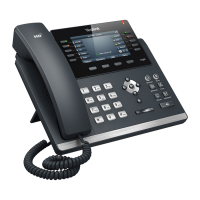Administrator’s Guide for SIP-T46G IP Phone
10
The initialization process of the IP phones is responsible for network connectivity and
operation of the IP phones in your local network.
Once you connect your IP phone to the network and to an electrical supply, the IP phone
begins its initialization process.
During the initialization process, the following events proceed:
Loading the ROM file
The ROM file resides in the flash memory of the IP phones. The IP phones come from the
factory with a ROM file preloaded. During initialization, the IP phones run a bootstrap
loader that loads and executes the ROM file.
Configuring the VLAN
If the IP phones are connected to a switch, the switch notifies the IP phones of the VLAN
information defined on the switch (if using LLDP). The IP phones can then proceed with
the DHCP request for its network settings (if using DHCP).
Querying the DHCP (Dynamic Host Configuration Protocol) Server
The IP phones are capable of querying a DHCP server. DHCP is enabled on the IP
phones by default. The following network parameters can be obtained from the DHCP
server during initialization:
IP Address
Subnet Mask
Gateway
Primary DNS (Domain Name Server)
Secondary DNS
You need to configure the network parameters of the IP phones manually if any of them
is not supplied by the DHCP server. For more information on configuring network
parameters manually, refer to Configuring Network Parameters Manually on page 17.
Contacting the auto provisioning server
SIP-T46G IP phones support the FTP, TFTP, HTTP, and HTTPS protocols for auto provisioning
and are configured by default to use TFTP protocol. If the IP phones are configured to
obtain configurations from the TFTP server, they will connect to the TFTP server and
download the configuration file(s) during booting up. The IP phones will be able to
resolve and apply the configurations written in the configuration file(s). If the IP phones
do not obtain the configurations from the TFTP server, the IP phones will use the
configurations stored in the flash memory.

